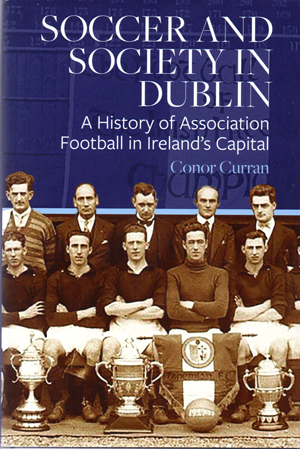CONOR CURRAN
Four Courts Press
€31.50
ISBN 9781801510394
Reviewed by Brian Trench

Brian Trench is a former senior lecturer at the School of Communications, Dublin City University, and former media officer at Bohemian Football Club.
A century ago Dublin was emerging as a football capital, home to the newly formed Football Association of the Irish Free State. In September 1923 this association joined the rapidly growing FIFA (International Federation of Football Associations) and successfully lobbied to be included in the tournament that FIFA organised as part of the 1924 Paris Olympics. The Ireland squad was drawn from three Dublin clubs plus Athlone Town. Indeed, the League of Ireland at that time comprised eleven Dublin teams and Athlone.
It had taken over 30 years and partition to get to this point. Association football or soccer was established in Belfast and region before it got a toehold in Dublin. Here, it faced the popularity of rugby and the force of the emerging GAA. Conor Curran recounts exhaustively the faltering first steps of Dublin clubs that drew support mainly from professional, military and clerical sectors. He gives summaries of hundreds of matches, club formations (and dissolutions), venue changes, player recruitment and losses, committee formations and growing attendances in charting the game’s progress from precarious, marginal status in the early 1890s to the most popular sport in the city by 1910, with a decidedly different social character.
Just how that came about is not entirely clear and it may well be beyond the capacity of any historian to explain conclusively. Changing working hours were undoubtedly a factor but they don’t explain why working men gathered in their thousands to watch soccer matches rather than undertake other leisure pursuits. To this day, international friendly football matches in Dublin draw larger crowds—not just proportionately but also in real terms—than in most other European countries.
This book will be an invaluable resource for anyone aiming to add to the history of sport in Ireland along these or other lines. Curran has trawled morning, evening and weekly newspapers, as well as sports publications, for details of matches, teams and attendances. He has scoured the archives of the Football Association of Ireland, the Leinster Football Association and the Irish Football Association (Belfast) for critical decisions. There are over 3,000 footnotes in the book, as one documented event follows another. The 35-page index of personal and club names will be well thumbed.
Disappointingly, Curran received little cooperation from clubs in making their archives accessible. It would be interesting to know, indeed, whether the clubs have retained records systematically, in what condition they are held and what further information they might reveal. There may well be another parallel history to tell of the administration of the clubs, in which many more volunteers than players may have been involved. The cover picture on the book is a useful indication of this—in the full, uncropped version of the photograph of the Bohemian FC 1927–8 league-winning squad there are more men in suits than there are in playing strip.
Perhaps surprisingly, Curran found value in the archives of the Catholic archdiocese of Dublin, which took an active interest in the working-class game, mainly to offset the perceived malign secular influences. This is one of the several topics he explores away from the mainly chronological account of matches and clubs. The impact of the GAA ban on ‘foreign games’ and players’ working conditions are among other recurrent issues. The author is on especially sure ground when he deals with migration of players into and out of Dublin clubs, soccer migrants being the subject of one of his earlier books and several papers.
Other subjects relating to the ‘society’ in the book’s title are less well explored—for example, the other entertainments available to soccer’s audiences, the motivations and interests of club owners (with the exception of Joe Cunningham of Shamrock Rovers) and the Spartan facilities at club grounds. There are glimpses of some such topics, like the intergenerational and sibling involvement of many families in their chosen clubs, notably in the set of interviews with players and supporters.
There are also missed opportunities and errors, some admittedly relating to my own study of Bohemian FC’s early years, including references on consecutive pages to Charlie and Emmet Dalton as IRA activists and Bohemian footballers without any indication that they were brothers; references at different points to Dr Willie Hooper and to Dr S. Barry Hopper (incorrectly) without mention that the former was president of the FAI at the time when the latter, his son, was a driving force in college football; and the naming of Dubliner Patrick O’Connell as ‘one of the most successful’ player exports from the city without mention of his later 25-year career as a club manager in Spain, including of Barcelona.
Selected episodes would have merited deeper treatment within a narrative framework, perhaps at the loss of some isolated incidents. The author is shy about making assessments and from this account it would be hard to understand why at the end of the twentieth century journalist Daire Whelan wrote his cri de coeur, ‘Who stole our game?—the fall and fall of Irish football’.
Repetition of details such as the number of affiliations to the Leinster FA or attendances at cup finals could have been avoided with tables. Some very long, convoluted sentences, reference to Seán T. O’Kelly as taoiseach, misspellings of club and personal names, and—excuse my sensitivity—the repeated naming of Bohemian FC (see the cover picture) as Bohemians FC should not have survived the editing process.
